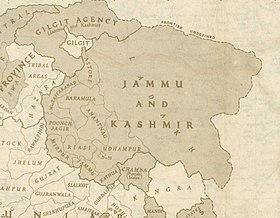Pahari (Poonchi)
| Pahari | |
|---|---|
| Punchhī, Pahāṛī | |
| پونچھی, پہاڑی | |
 | |
| Region | Poonch Division of Azad Kashmir Poonch District of Jammu and Kashmir |
| Language codes | |
| ISO 639-3 | – |
| Glottolog | punc1239 Punchhi |
Pahari (پہاڑی), also known as Poonchi Pahari (پونچھی) is a language spoken in the Poonch Division of Pakistan-admistered Azad Kashmir alongside areas of neighboring Poonch District of Indian-administered Jammu and Kashmir.[1][2][3]
The term pahari or pahadi originates from the word pahad, meaning 'mountain' or 'hill', used often as an ambiguous term for the languages of the peoples belonging to the region of the Western Himalayas and areas surrounding it, collectively deemed Pahari.




Pahari speakers, focusing on language choices during social interactions and the pattern of language shift in the Poonchi dialect of Pahari. It also aims to find out the linguistic preferences and shifts within the Pahari-speaking community. Using a stratified random sampling technique, data were collected from 300 respondents through a structured questionnaire. The questionnaire, designed in a multiple-choice format, facilitated the collection of relevant information from the informants. The major findings reveal a notable trend towards the adoption and promotion of Urdu and English among Pahari speakers, influenced by the increasing exposure to Urdu in academic and social settings and the global prominence of English. The linguistic landscape in Rawalakot, district Poonch reflects a pattern of multilingualism, where individuals possess varying levels of proficiency in Pahari, Urdu, and English. The fourth generation shows a pronounced shift towards bilingualism in Urdu and English, signaling a diminishing proficiency in Pahari. The study suggests a trajectory of language shift from Pahari towards Urdu and English, driven by socio-economic factors and changing societal norms.[4]
References
[edit]- ^ Martínez, Valerie (3 May 2022). Each and Her. University of Arizona Press. p. 30. doi:10.2307/j.ctv2jhjw5h.31.
- ^ Abbasi 2010, p. 104.
- ^ Grierson 1919, p. 505 and corresponding map.
- ^ Kashmiri, Naveed Sarwar Shad; Rashid, Haroon Ur (30 September 2023). "Language Dynamics among Pahari Speakers: Trends in Language Use and Shift over Time". Pakistan Languages and Humanities Review. 7 (3): 996–1013. doi:10.47205/plhr.2023(7-III)86 (inactive 13 November 2024). ISSN 2708-6461.
{{cite journal}}: CS1 maint: DOI inactive as of November 2024 (link)
